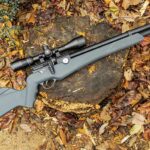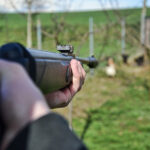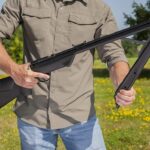Table of Contents
- 1 Trying to decide between the .30-06 Springfield and 6.5 Creedmoor cartridges? Here’s what you need to know about them.
- 2 .30-06 vs 6.5 Creedmoor Podcast
- 3 History Of The .30-06 Springfield and 6.5 Creedmoor
- 4 30-06 vs 6.5 Creedmoor: Cartridge Sizes
- 5 6.5 Creedmoor vs 30-06 Ballistics
- 6 6.5 Creedmoor vs 30-06
- 7 30-06 vs 6.5 Creedmoor Barrel Life
- 8 6.5 Creedmoor vs 30-06 Ammo
- 9 6.5 Creedmoor vs 30-06 Rifles
- 10 6.5 Creedmoor vs 30-06: Which Is Right For You?
- 11 6.5 Creedmoor For Elk Hunting Podcast
- 12 NEXT: 308 vs 30-06 SPRINGFIELD vs 300 WIN MAG: WHICH SHOULD YOU HUNT WITH?
- 13 Enjoy this article comparing the .30-06 Springfield and 6.5 Creedmoor cartridges? Please share it with your friends on Facebook and Twitter.
Trying to decide between the .30-06 Springfield and 6.5 Creedmoor cartridges? Here’s what you need to know about them.
While the .30-06 Springfield has a long history of use as an extremely effective all-around hunting cartridge, the 6.5 Creedmoor is much newer to the hunting game. Both offer certain advantages to hunters, but there are some significant differences between the 6.5 Creedmoor vs 30-06 cartridges you should be aware of.
Unfortunately, as is the case with many things involving the 6.5 Creedmoor, there’s a lot of misinformation and hype out there regarding the capabilities of these cartridges. Not surprisingly, it’s really easy to get confused when trying to understand their actual strengths and weaknesses.
What do the .30-06 Springfield and 6.5 Creedmoor have to offer hunters? Does the 6.5 Creedmoor really live up to the hype? Or is the legendary .30-06 still the better choice for most people?
In this article, I’m going to do a detailed comparison of the 6.5 Creedmoor vs 30-06 in an effort to answer the above questions and discuss the pros and cons of each one to help provide some insight into which cartridge will work best for you.
Before we get started, I have a couple of administrative notes:
Some of the links below are affiliate links. This means I will earn a small commission (at no extra cost to you) if you make a purchase. This helps support the blog and allows me to continue to create free content that’s useful to hunters like yourself. Thanks for your support.
Additionally, I recorded an entire podcast episode on this exact subject. If you’d rather listen than read, click the appropriate link below to listen to this episode on your preferred podcasting service.
.30-06 vs 6.5 Creedmoor Podcast
Apple | Google | iHeart | Spotify | Stitcher
History Of The .30-06 Springfield and 6.5 Creedmoor
The U.S. Army decided it needed a new cartridge to replace the .30-40 Krag and .45-70 Government cartridges used by American Soldiers in the Spanish American War. While the United States was victorious in that war, the Army suffered heavy casualties at the hands of Spanish troops in Cuba armed with Mauser rifles chambered in ballistically superior 7mm Mauser in 1898.
With that in mind, Army leadership wanted a new service rifle that could compete with the revolutionary new Mauser rifle. Among other things, they were looking for a new bolt-action rifle designed from the start with a stronger action capable of safely firing more powerful smokeless ammunition, with a “claw” extractor for more reliable feeding and extraction, and that could be quickly loaded with 5-round stripper clips.
In the end, the new 1903 Springfield was modeled heavily on (some might even say copied) the 1893 Spanish Mauser rifle. The new rifle was originally chambered in the .30-03 Springfield cartridge, which fired a 220gr round nosed bullet at approximately 2,300fps.
While the .30-03 cartridge did provide a modest improvement in performance over the .30-40 Krag, the Army still wasn’t completely happy with the performance of the cartridge.
For this reason, designers made a few tweaks to the design of the .30-03 Springfield. Switching over to a revolutionary new 150gr “spitzer” (pointed) bullet fired at a muzzle velocity of 2,700 fps gave them the results they were looking for.
Named after the year it was formally introduced, the high velocity .30-06 Springfield was a significant improvement over previous military cartridges used during that era.
In addition to extensive use with the U.S. military through World War II in the 1903 Springfield and M1 Garand rifles, the .30-06 Springfield cartridge also rapidly caught on with the big game hunting and shooting communities in the United States during the early 20th Century.
The old .30-06 remains one of the most popular centerfire rifle cartridges used by hunters and shooters in the United States (as well as many other parts of the world) to this day. Not surprisingly, the .30-06 has also served as the parent for many other cartridges (like the .25-06 Remington, .270 Winchester, and .35 Whelen).
Now let’s fast forward a few decades.
Dave Emary of Hornady Manufacturing and Dennis DeMille of Creedmoor Sports saw an opportunity to build a new cartridge for high power rifle competition shooting in the early 2000s.
Specifically, they wanted to build an ideal long range shooting cartridge that would fit in a short action rifle and was just as accurate as the .308 Winchester at long distance. However, the catch was they wanted the new cartridge to have less recoil, less wind drift, and a flatter trajectory.
By modifying a .30 Thompson Center (.30 TC) case to shoot .264″ bullets, they successfully built a cartridge optimized for use with 4350 class propellants with a relatively large case capacity that could also accommodate long, heavy, high ballistic coefficient (BC) bullets without intruding into the powder column.
Named the 6.5 Creedmoor (sometimes misspelled Creedmoore or Creedmore) in honor of the Creedmoor Matches and designed for use with a relatively fast 1:8″ rifling twist rate, Emary and DeMille were quite successful in their goal of building the ideal competition shooting cartridge with a relatively flat trajectory.
A typical 6.5 Creedmoor load shoots a 140-grain bullet at about 2,700 fps (2,266 ft-lbs). So, the 6.5 Creedmoor does not have eye popping ballistics, but it is very accurate, uses high BC bullets that retain energy and resist wind drift exceptionally well, and has moderate recoil.
For those reasons, the cartridge has seen a great deal of success in the hands of competition shooters and recently made the jump into the mainstream hunting community. The 6.5 Creedmoor cartridge has become extremely popular among hunters and shooters who appreciate the mild recoil and great extended range performance of the cartridge in recent years as well.
If you’d like to learn more about how the 6.5 Creedmoor compares to the .308 Winchester in more detail, read the article below:
6.5 Creedmoor vs 308 Winchester Debate Settled
30-06 vs 6.5 Creedmoor: Cartridge Sizes
You can see differences between the .30-06 Springfield and the 6.5 Creedmoor in the photos below.
First, the .30-06 Springfield is physically quite a bit larger than the 6.5 Creedmoor.
The .30-06 cartridge has a longer overall length and uses a longer case length than the 6.5 Creedmoor. That said, the 6.5 Creedmoor is designed to fit in a short action rifle while the longer .30-06 requires the use of a long or standard length action.
While both cartridges have the same .473″ rim diameter, the 6.5 Creedmoor has a steeper 30 degree shoulder while the .30-06 has a 17.5 degree shoulder.
Even so, the .30-06 has a much larger case capacity than the 6.5 Creedmoor since it’s so much longer.
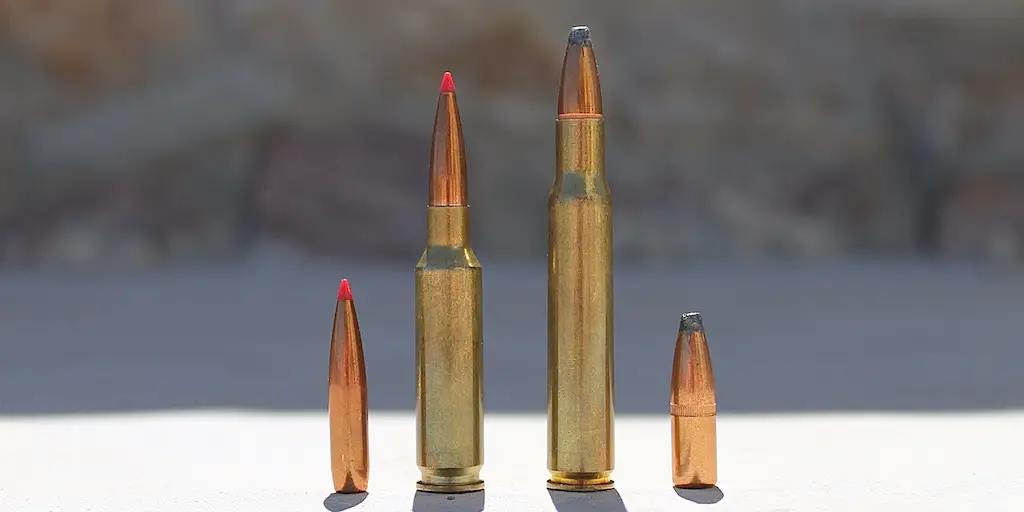
Bullet size is another one of the other obvious differences between the 6.5 Creedmoor vs 30-06. Each cartridge uses different diameter bullets: .264″ for the Creedmoor and .308″ for the Springfield.
Everything else being equal, the smaller diameter 6.5mm bullets have a higher ballistic coefficient and a higher sectional density than the larger diameter bullets of the same weight from the .30-06 Springfield.
However, the .30-06 generally uses heavier bullets than the 6.5 Creedmoor.
Specifically, the 6.5 Creedmoor most often utilizes bullet weights in the 95-160 grain range, with 120 grain, 129 grain, 140 grain, and 143 grain bullets being the most common.
On the other hand, though it’s possible to find .30-06 ammo shooting bullets in the 110-220 grain range, most .30-06 Springfield factory loads use 150 grain, 165 grain, 180 grain, or 200 grain bullets.
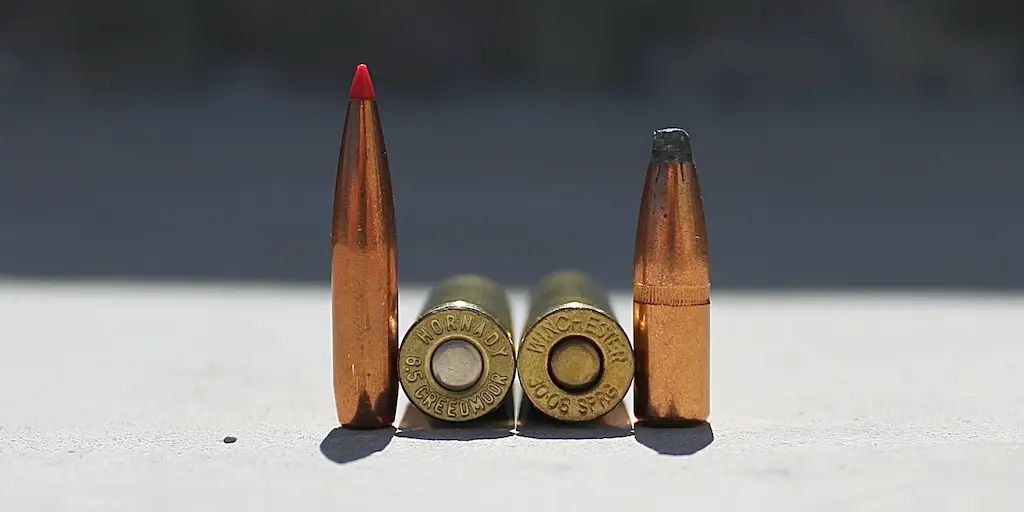


The 6.5 Creedmoor is also loaded to a higher pressure than the .30-06 (62,000psi vs 60,000psi).
Note: while the powder capacity figures listed below do give a good indication of the differences between the two cartridges, exact case capacities vary slightly according to the brand of brass used.


6.5 Creedmoor vs 30-06 Ballistics
Not surprisingly, the differences in the external dimensions of the 6.5 Creedmoor and the .30-06 Springfield translate into some pretty significant differences in their ballistic performance. This is illustrated in the table below comparing Hornady Precision Hunter, Nosler Trophy Grade, and Winchester Deer Season XP factory ammunition.
I chose those particular factory loads because they provide a good demonstration of the performance of each cartridge when using wide spectrum of different bullets. The Winchester loads use light for caliber bullets, the Nosler loads use heavy for caliber bullets, and the Hornady loads use heavy for caliber, exceptionally aerodynamic bullets for each cartridge.
Specifically, the 6.5 Creedmoor loads use a 125gr Extreme Point (.540 BC), a 140gr Partition (.490 BC), and a 143gr ELD-X (.625 BC). The .30-06 loads use a 150gr Extreme Point (.392 BC), a 178gr ELD-X (.552 BC), and a 180gr Partition (.474 BC).
Note that the bullets used by 6.5 Creedmoor in each load are more aerodynamic than those used by the .30-06 Springfield for the exact same load. More on this in a minute.
All six loads used a 200 yard zero.
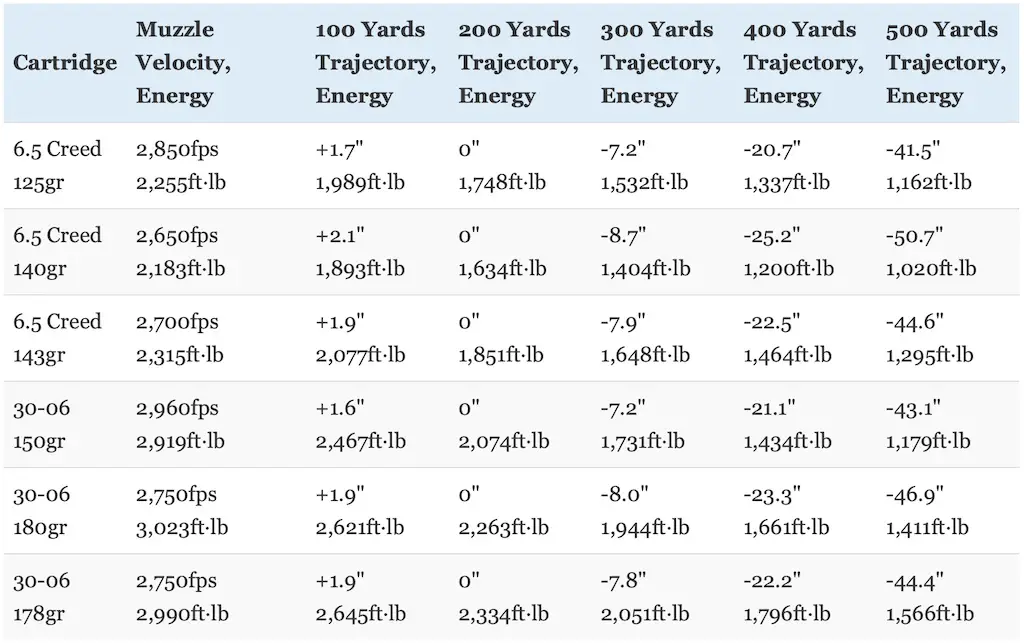

As you can see, the .30-06 fires a heavier and larger caliber bullet at a slightly faster, though very similar overall velocity to those produced by the 6.5 Creedmoor with lighter bullets. However, the 6.5 Creedmoor does use more aerodynamic bullets that retain energy and velocity a little better than those used by the .30-06.
The end result is that, with the exception of the Nosler Partition load (where the 30-06 has a definite edge), the two cartridges have a surprisingly comparable trajectory.
The .30-06 Springfield does have significantly more kinetic energy than comparable 6.5 Creedmoor loads at all ranges. However, since the 6.5 Creedmoor uses more aerodynamic bullets with a higher ballistic coefficient, the gap in performance between the cartridges slightly decreases in size as range increases.
Specifically, the .30-06 Springfield has about 21-39% more muzzle energy than the 6.5 Creedmoor with these three particular loads. That turns into a 17-38% advantage in favor of .30-06 at 500 yards, which isn’t a gigantic change from the difference in energy at the muzzle.
So, I think it’s fair to say that, while the Creedmoor does “catch up” a little bit at longer range, the .30-06 Springfield still hits significantly harder than the 6.5 Creedmoor at all reasonable hunting ranges.
We’ll talk more about those numbers and what they mean in a minute.
The chart below compares how much a 10 mile per hour crosswind impacts those same 6.5 Creedmoor and .30-06 loads out to 500 yards.
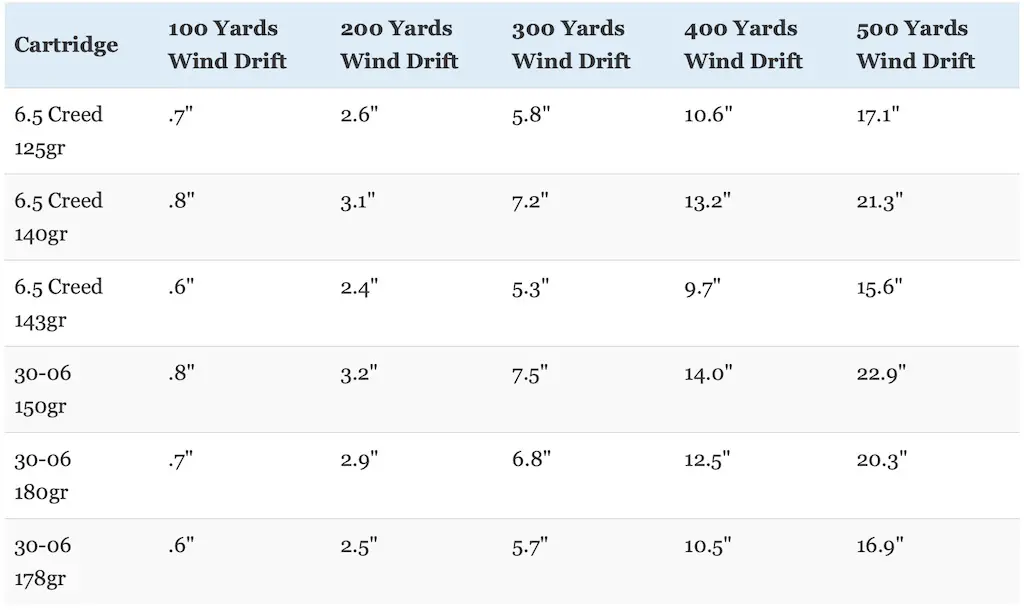

This is one of those areas where the 6.5 Creedmoor shines.
As you can see, even though the bullets from the .30-06 are heavier and going a little faster, the 6.5 Creedmoor uses much more aerodynamic bullets that offer better resistance to wind deflection.
The .30-06 Deer Season XP load drifts almost 6″ more than the 6.5 Creedmoor at 500 yards. The Hornady ELD-X loads track each other very closely, but the 6.5 Creedmoor does have a small advantage of about 1.3″ with those loads at 500 yards.
That Nosler Partition load is the one exception and the .30-06 actually has a small advantage of about 1″ at 500 yards in that case.
The differences are of course smaller at shorter range.
All things considered, the 6.5 Creedmoor has a small advantage over the .30-06 as far as wind drift goes.
Now let’s talk about recoil.
The table below compares the recoil produced by handloads that approximate the performance of the Hornady Precision Hunter factory load above for each cartridge when fired from identical 7 pound rifles.
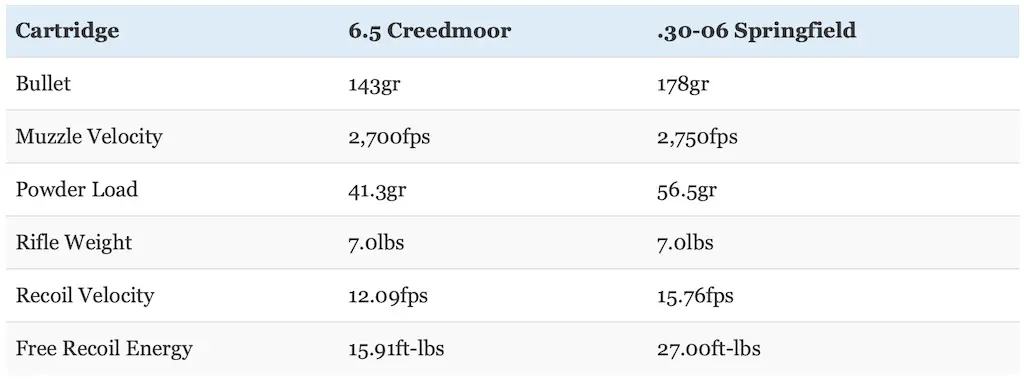

Felt recoil will vary from shooter to shooter and rifle to rifle, but free recoil energy is still a useful way to compare cartridges.
As you can see, the .30-06 has significantly more recoil than the 6.5 Creedmoor. In this case, the .30-06 produces nearly 70% more free recoil energy than the 6.5 Creedmoor.
After all, the 6.5 Creedmoor was designed specifically to be a mild recoiling and sweet shooting cartridge while the .30-06 is a more powerful and heavier hitting cartridge.
Basically, while the .30-06 still has manageable recoil for most hunters and shooters, the cartridge should be expected to hit a little harder on both ends, which is exactly the case.
This can be mitigated to a certain extent with the use of a suppressor, muzzle brake, or a good recoil pad. So the extra recoil of the .30-06 isn’t necessarily a deal breaker for many people. It’s still worth considering though.
Don’t underestimate the impact that recoil has on the ability of a person to shoot accurately either. Some people do handle recoil better than others, but all other things being equal, they will absolutely shoot more accurately with a milder recoiling cartridge.
Additionally, there are a couple of other factors that are also worth discussing.
First, the .30-06 uses larger diameter bullets than the 6.5 Creedmoor.
Specifically, the larger diameter .308″ bullets used by the .30-06 Springfield have about 36% more frontal surface area (also known as cross sectional area) than the 6.5 Creedmoor (.0745 vs .0547 square inches). All other things being equal, a bigger bullet will make a bigger hole, cause more tissue damage, and result in more blood loss.
This is a definite advantage in favor of the .30-06.



Especially when combined with the fact that the .30-06 carries more kinetic energy downrange than the 6.5 Creedmoor, those larger diameter bullets are certainly helpful when hunting big game.
On the other hand, as we covered earlier, those longer, heavy for caliber .264″ bullets have a higher ballistic coefficient than the most common bullets used in the .30-06 Springfield though.
The 6.5mm bore diameter is also in something of a sweet spot where it’s easier to manufacture very high BC bullets that aren’t especially heavy. Those aerodynamic projectiles don’t slow down as fast and are more resistant to wind drift.
They also have a relatively high sectional density (SD).
Sectional density (SD) is a measure of the ratio of the diameter of a projectile to its mass. All other things equal, a heavier projectile of a given caliber will be longer and therefore have a higher sectional density and consequently penetrate deeper than projectiles with a lower mass and sectional density.
150 grain, 180 grain, and 200 grain .308″ bullets have sectional densities of .226, .271, and .301 respectively. At the same time, 120 grain, 129 grain, 140 grain, and 143 grain .264″ bullets have sectional densities of .246, .264, .287, and .293.
There’s some overlap here, but with the exception of the absolute heaviest .30-06 bullets, the 6.5 Creedmoor has a slight edge in sectional density.
There’s nothing wrong with the killing power or penetration capabilities of the .30-06, but this might help explain why the 6.5 Creedmoor tends to perform better on game than the modest ballistics of the cartridge on paper would suggest.
What about 6.5 Creedmoor vs .30-06 accuracy?
The .30-06 Springfield is certainly capable of outstanding accuracy (often sub-MOA) and was commonly used in long range target shooting competitions for a many decades. However, the heavier recoil of the cartridge can make shot placement more challenging for certain people who are more recoil shy.
On the other hand, the 6.5 Creedmoor was specifically designed as a mild recoiling competition shooting cartridge. At the same time, since it utilizes .264″ bullets, there is a bigger selection of high BC and high SD match grade hunting bullets available for the cartridge.
Basically, the low recoil and wide selection of high BC match grade hunting bullets for the 6.5 Creedmoor facilitate exceptional accuracy and help maximize the shooting abilities of the hunter using the cartridge to a greater degree than the .30-06.
That’s not to say that the .30-06 Springfield isn’t accurate or that there aren’t a bunch of good quality bullets available for it. It’s just that the overall design of the 6.5 Creedmoor gives that cartridge an edge over the .30-06 Springfield in potential accuracy at extended range.
So where do we stand with each cartridge?
6.5 Creedmoor vs 30-06
The .30-06 Springfield fires larger diameter and heavier bullets at a slightly faster velocity than the 6.5 Creedmoor. The 6.5 Creedmoor uses more aerodynamic bullets, so the two cartridges have a similar trajectory. The .30-06 has significantly more kinetic energy at typical hunting ranges, but the 6.5 Creedmoor has less recoil.
With a comparable trajectory, less recoil, and a little less wind drift, the 6.5 Creedmoor does have a few definite, though not gigantic, advantages over the .30-06 Springfield at typical hunting ranges. This makes the cartridge a tiny bit more forgiving of range or wind estimation errors than the .30-06 Springfield.
While that’s certainly something to keep in mind, laser rangefinders and modern scopes with easily adjustable ballistic turrets (like the Leupold VX-5) make adjusting for bullet drop much simpler now than it was a few decades ago.
The most popular bullet weights for the 6.5 Creedmoor also tend to be more aerodynamic than the most popular bullet weights used by the .30-06. So, the small advantages the 6.5 Creedmoor cartridge has with wind drift grow slightly at extended range.
Those aforementioned strengths of the 6.5 Creedmoor all facilitate precise shot placement, which is extremely important when it comes to ethically taking game.
Those 6.5mm bullets also tend to have a higher sectional density as well, which assists with penetration to help the cartridge “punch above its weight” in a manner similar to the 6.5×55 Swedish, 7x57mm, or 9.3x62mm Mauser cartridges.
On the other hand, while the 6.5 Creedmoor does have some slight advantages over the .30-06 in terms of wind drift, there’s not a gigantic difference between them. Depending on the exact ammo used, the .30-06 actually has a trajectory that’s roughly comparable to the 6.5 Creedmoor and that advantage in wind drift can shrink or even flip in favor of the .30-06.
For this reason, I think the killing power of the .30-06 vs 6.5 Creedmoor is the biggest difference between them.
The .30-06 has significant advantage when it comes to frontal surface area (which gives a tiny bit more room for error with shot placement) and kinetic energy. It also uses heavier bullets.
For one thing, the .30-06 carries a lot more kinetic energy downrange than the Creedmoor. The cartridge also uses significantly heavier bullets and has a big advantage when it comes to frontal surface area. Those traits give hunters a tiny bit more room for error in shot placement when compared to the 6.5 Creedmoor.
Add it all up and the .30-06 hits with a lot more “authority” than the 6.5 Creedmoor and the cartridge is renowned worldwide for being an extremely effective hunting round on all manner of game. The gap in performance in this area is not as significant as the difference between the .300 Win Mag and the 6.5 Creedmoor, but it’s still pretty big.
30-06 vs 6.5 Creedmoor Barrel Life
The 6.5 Creedmoor cartridge in particular has a reputation for being rough on barrels. Even though the 6.5 Creedmoor typically uses less powder than the .30-06, it does so in a smaller sized space.
This means that, in general, the 6.5 Creedmoor will simply wear out barrels faster than the .30-06 Springfield. Exactly how fast that occurs depends on a number of factors like the quality of the barrel, the exact ammunition used, etc.
For serious target shooters, this can be a concern. However, the good news for hunters is that typical barrel life for all of these cartridges is more than enough to last for many, many years of hunting with no issues at all.
So, there isn’t a tremendous practical difference in 6.5 Creedmoor vs 30-06 barrel life as far as most hunters are concerned.
6.5 Creedmoor vs 30-06 Ammo
The .30-06 Springfield and the 6.5 Creedmoor are both extremely popular centerfire rifle cartridges. Both consistently rank among the Top 10 and potentially Top 5 most popular centerfire rifle cartridges in the USA each year. Of the two, the .30-06 has a much longer track record, but the 6.5 Creedmoor likely edges the .30-06 in popularity today by a small margin.
So, they’re both popular options in common use and ammo is usually very easy to find for both.
In general, prices are often comparable, but .30-06 ammo is sometimes a little cheaper than 6.5 Creedmoor ammo.
The big ammunition manufacturers like Barnes, Berger, Browning, Federal Premium, Hornady, HSM, Norma, Nosler, Remington, Sierra, Sig Sauer, Swift, and Winchester produce an incredible variety of ammo for the .30-06 Springfield and 6.5 Creedmoor.
In each case, there is normally a good selection of bullet types and weights for each cartridge suitable for big game hunting ranging from stuff like Remington Core Lokt and Winchester Super X ammo to Federal Premium Gold Medal and Hornady Precision Hunter factory loads.
At the same time, predator and varmint rounds like the Hornady V-Max and Nosler Varmageddon are sometimes available for the .30-06, but they’re much more common with the 6.5 Creedmoor.
During normal times, it’s usually very easy to find ammo for both cartridges and almost any gun or sporting goods store will have a wide variety of .30-06 and 6.5 Creedmoor ammo in stock.
Ammo availability is also usually excellent online and the bigger retailers typically have a good selection of quality factory ammo for both cartridges as well.
BUY SOME GREAT 6.5 CREEDMOOR AMMO HERE
BUY SOME EXCELLENT 30-06 SPRINGFIELD AMMO HERE
If you’d like to learn more about some of the various hunting ammunition choices for the 6.5 Creedmoor and 30-06 cartridges, read these articles:
Best 6.5 Creedmoor Ammo For Hunting Elk & Deer
Best 30-06 Ammo For Hunting Elk, Deer, Bear, Hogs, & Other Game
Handloaders will appreciate the fact that reloading components for both cartridges are also readily available and there’s an especially wide variety of bullet choices for each cartridge. So, you should not have any trouble working up a good custom load for either one if you like to handload.
The 6.5 Creedmoor shoots the same .264″ bullet size that’s also used by the 6.5×55 Swede, 6.5 Grendel, .260 Rem, and 6.5 PRC (among others).
The .30-06 Springfield uses the same .308″ bullet size as the .308 Winchester/7.62x51mm NATO, .30-30 Winchester, .300 Win Mag, 300 WSM, .300 Ultra Mag, and .300 PRC.
Bullets like the Barnes LRX, TSX, and TTSX, the Berger VLD and Hybrid Hunter, the Hornady ELD-X, GMX, InterBond, InterLock, SST, and V-Max, the Nosler AccuBond, Ballistic Tip, E-Tip, and Partition, the Sierra GameChanger and GameKing, the Swift Scirocco and A-Frame, (just to name a few) are options for if you want to reload the 6.5 Creedmoor and the .30-06 Springfield.



6.5 Creedmoor vs 30-06 Rifles
In addition to the typically great selection of quality hunting ammunition available in 6.5 Creedmoor and .30-06, there are also many excellent rifles manufactured in these cartridges.
Both cartridges are extremely common in bolt-action rifles. In fact, just about every really popular bolt-action hunting rifle in current production is available in both cartridges.
For instance, both the 6.5 Creedmoor and .30-06 Springfield are available in several different versions of the Remington Model 700 and Winchester Model 70. The same goes for the Browning X-Bolt, Browning AB3, Christensen Arms Ridgeline, Mossberg Patriot, Ruger American, Ruger Hawkeye, Savage Axis, Savage 110, Tikka T3 and Tikka T3x, Weatherby Vanguard, and Winchester XPR.
Remember when I mentioned earlier that the 6.5 Creedmoor will fit in a short-action rifle while the .30-06 Springfield requires the use of a long/standard length action rifle? Well, this means that rifles chambered in 6.5 Creedmoor have a shorter bolt than the exact same rifle chambered in .30-06.
Additionally, (this has nothing to do with a rifle having a short or a long-action), gun manufacturers sometimes tend to put longer barrels on rifles chambered in .30-06. This is not a hard and fast rule though. 22″ barrels are very common with both cartridges and it’s not unusual to find rifles with 20″, 24″, or even sometimes 26″ barrels in 6.5 Creedmoor or .30-06.
So all things considered, rifles chambered in .30-06 Springfield will sometimes be slightly longer, heavier, and more unwieldy than short action rifles chambered in 6.5 Creedmoor.
The Ruger Hawkeye Hunter and the Winchester Model 70 Super Grade illustrate these differences well.
When chambered in 6.5 Creedmoor, the Hawkeye rifle has a 22″ barrel, an overall length of 42″, and weighs 7.2 pounds. The same rifle chambered in .30-06 Springfield also has a 22″ barrel, is 42.75″ long, and weighs 7.4 pounds.
At the same time, the Winchester Model 70 Super Grade in the 6.5 Creedmoor chambering has a 22″ barrel, an overall length of 42.25″, and weighs 7.75 pounds. The same rifle chambered in .30-06 Springfield has a longer 24″ barrel, is 44.75″ long, and weighs 8.25 pounds.
Like I said, that’s not always the case, but rifles in .30-06 are often a little longer, heavier, and more unwieldy that rifles in 6.5 Creedmoor.
Having a shorter and lighter rifle is more important on some hunts than on others. So, just keep that in mind.
BUY A GREAT 6.5 CREEDMOOR RIFLE HERE
BUY A NICE 30-06 SPRINGFIELD RIFLE HERE
Read the article below if you’d like to learn more details about some of the various hunting rifle choices for the 6.5 Creedmoor.
Best 6.5 Creedmoor Rifles For Hunting – Ultimate Guide
6.5 Creedmoor vs 30-06: Which Is Right For You?
Do you primarily hunt medium sized game like whitetail deer, feral hogs, or black bear at ranges within 200 yards? Both are extremely effective deer hunting cartridges and will absolutely get the job done on medium sized game if you do your part. The .30-06 in particular is a great deer hunting cartridge and remains one of the most popular North American hunting cartridges. The 6.5 Creedmoor is also an outstanding cartridge for the average hunter in North America hunting deer and feral hogs. I personally wouldn’t use it on black bear, but other people have with a lot of success in that role.
If you’re going to be hunting in thick brush or in the tight confines of a deer stand, remember what I just mentioned about the size difference with 6.5 Creedmoor vs 30-06 rifles. That extra couple of inches in overall length of a rifle can be a real headache to deal with when trying to quickly and quietly maneuver for a shot.
Are you looking for the cartridge better suited for long range hunting for game like mule deer or pronghorn antelope in open country where you might need to take a shot at several hundred yards? Once again, they’ll both work really well in this role. The .30-06 Springfield is a very good choice for this sort of hunting, but so is the 6.5 Creedmoor. The .30-06 carries more energy out past 200 yards, but most good 6.5 Creedmoor hunting loads still carry more than 1,000 ft-lbs of energy out to 500 yards. The advantages the 6.5 Creedmoor cartridge has in terms of bullet drop and wind drift start to become much more important at longer range as well.
Do you want a hunting cartridge that’s well suited for caribou, moose, elk, eland, kudu, or red stag hunting?
The 6.5 Creedmoor will get the job done in a pinch, but hunters need to be extremely careful with their shot angles (broadside or slightly quartering shots are best) and should probably stick to shots under 250 yards on elk sized game.
Yes, you can hunt elk with it, but you need to be aware of a couple of things before you go down that road.
To that end, I recorded an entire podcast episode on elk hunting with the 6.5 Creedmoor with someone who has cleanly taken elk with the cartridge. Our discussion does a great job of covering the pros and cons of the 6.5 Creedmoor for elk hunting and anyone planning on going elk hunting in the future should definitely listen to this interview.
Just click the appropriate link below to listen to this episode on your preferred podcasting service. Be sure to hit that “subscribe” or “follow” button if you like the show!
6.5 Creedmoor For Elk Hunting Podcast
Apple | Google | iHeart | Spotify
The .30-06 Springfield is hands down the better choice for hunting bigger game animals since it shoots significantly heavier and larger diameter bullets that carry more kinetic energy downrange. The result is that the .30-06 has a longer effective range and gives hunters more flexibility with shot angles on really big game when compared to the 6.5 Creedmoor.
Regardless of which cartridge you choose, use a controlled expansion projectile and a heavier bullet weight for your elk or moose hunt.
Are you specifically hunting brown or grizzly bear? What if you hunt in Canada or Alaska and need a heavy hitting cartridge just in case you find yourself on the wrong end of a grizzly/brown bear attack? While I’d prefer to carry something heavier like a .300 Win Mag or a .338 Win Mag in grizzly country, I’d definitely go with the .30-06 over the 6.5 Creedmoor since it uses larger diameter and heavier bullets. Make sure you use premium, heavy for caliber 200gr or 220gr bullets if you go that route.
For what it’s worth, Roy Lindsley used a .30-06 Springfield to take the current Boone & Crockett record Alaska brown bear back in 1952. But then again, that hunt took place before cartridges like the 7mm Remington Magnum, .300 Winchester Magnum, and .338 Winchester Magnum even existed.
Are you sensitive to recoil and in need of a serious low recoil cartridge? The 6.5 Creedmoor has significantly less recoil than the .30-06 Springfield, especially in a lighter rifle. So, this cartridge is especially well suited to new, small framed, and or recoil shy hunters. Indeed, the 6.5 Creedmoor is extremely popular for children to use for deer hunting because it is so effective on deer and has such mild recoil.
Do you want the round that is best suited for target shooting out past 400 yards or so in a precision rifle? Both will work and have excellent reputations for precision shooting at longer ranges, but since we’re just punching paper or banging steel at long distances, I lean towards the 6.5 Creedmoor since it has such mild recoil and is specifically designed to use very high BC, match grade bullets.
The 6.5 Creedmoor and .30-06 Springfield are both excellent rifle cartridges. While the 6.5 Creedmoor is the latest flavor of the week and does offer certain advantages over the .30-06 in some aspects, the old “aught six” is still getting it done well over a century after coming on the scene!
Though the differences between them (6.5 Creedmoor vs 30-06) are fairly significant in certain respects, they’re both suitable for many hunting tasks.
So, carefully analyze your potential needs before making a decision. In the end, a lot of this decision comes down to personal preference. So, choose the one that you feel most comfortable with and it will probably serve you well afield. Good luck!
NEXT: 308 vs 30-06 SPRINGFIELD vs 300 WIN MAG: WHICH SHOULD YOU HUNT WITH?
The Lyman 50th Edition (p183-184 and p246-250) and Hornady 10th Edition (p317-322 and p510-522) reloading manuals were used as references for the history of the cartridges. I obtained the data used to compare the trajectory of the cartridges from Hornady (here and here), Nosler (here and here), and Winchester (here and here). Data used to calculate recoil was obtained from the Hornady reloading manual. Case capacities were obtained from Chuck Hawks (here and here). Maximum pressure obtained from SAAMI (p23 & 29). I used ShootersCalculator.com to compare trajectory and recoil for the cartridges.
Make sure you follow The Big Game Hunting Blog on Facebook, Instagram, Twitter, and YouTube.











































